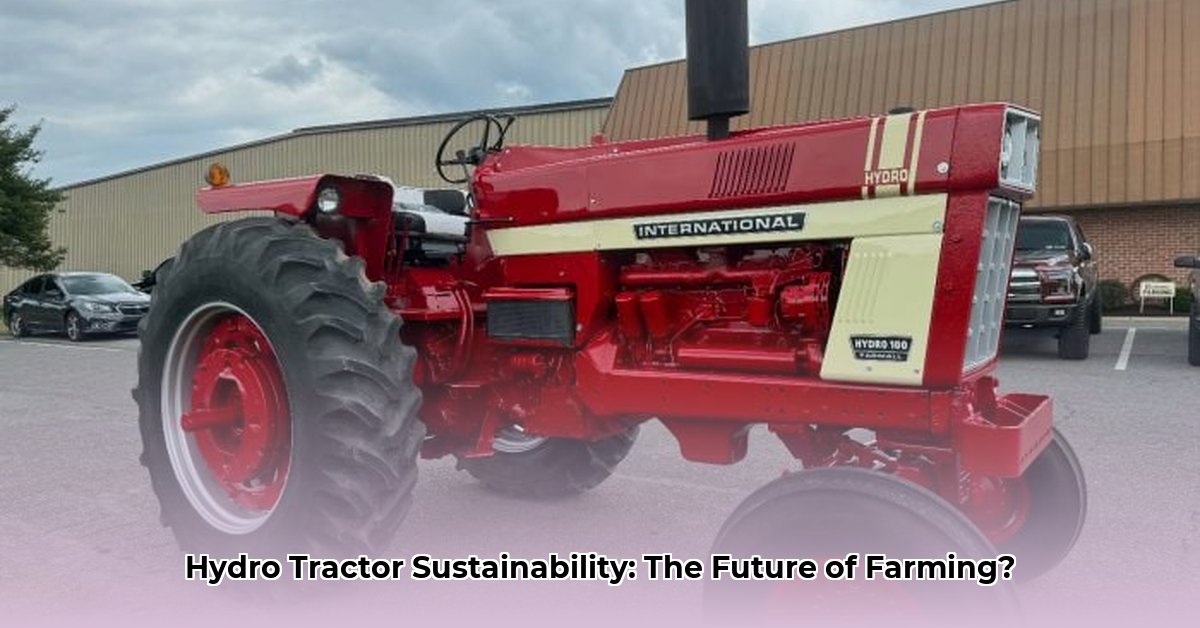
Technical Specifications and Historical Context
The International Harvester Hydro 100, a vintage hydro-static drive tractor from the 1970s, presents a unique case study in sustainable agriculture. This machine, boasting approximately 104 horsepower at the power take-off (PTO) from its 7.1-liter diesel engine and weighing 12,130 pounds, represents a significant departure from modern tractor technology. Its robust build and relatively simple mechanics were characteristic of the era, but how do these features translate into modern sustainability metrics? Understanding its historical context is crucial for a comprehensive evaluation. The Hydro 100's size and weight—typical for its time—directly impact soil compaction, a critical factor in modern sustainable agriculture. This analysis explores the tradeoffs between the Hydro 100’s legacy design and contemporary sustainability goals. For perspective on modern tractor costs, see this helpful resource: new tractor prices.
Analysis of Sustainability Aspects
Fuel Efficiency and Greenhouse Gas Emissions
Compared to modern tractors, the Hydro 100's fuel efficiency and emissions were likely significantly higher. Precise data is scarce, however, making direct comparison challenging. Ongoing research leveraging emissions modeling techniques aims to estimate historical values, though complete accuracy remains elusive due to data limitations. Advancements in diesel engine technology and emission control systems in modern tractors suggest a substantial difference in fuel consumption and greenhouse gas emissions. This lack of precise data emphasizes the need for further research to accurately quantify the Hydro 100's environmental impact. How can we improve data collection methods for accurate emissions estimations of vintage tractors?
Repairability and Parts Availability
The Hydro 100's relative simplicity compared to modern tractors may confer a repairability advantage. Its mechanical design, lacking complex electronics, may allow skilled mechanics to troubleshoot and repair common problems with readily available tools. However, parts availability presents a significant challenge. Finding replacement parts is often difficult and expensive, necessitating custom fabrication or sourcing from specialized vendors. This significantly inflates repair costs, potentially offsetting the benefits of simple mechanics. A comprehensive cost-benefit analysis comparing the Hydro 100's repair costs against those of modern tractors is needed, requiring detailed data on part pricing and repair duration.
Soil Compaction
The Hydro 100’s substantial weight raises concerns about soil compaction, a detriment to soil health and long-term agricultural sustainability. Heavy machinery can reduce aeration and water infiltration, negatively impacting crop yields. While some compaction is inherent in all agricultural practices, the Hydro 100's greater weight increases the risk. This risk is moderated by factors including soil type, operating conditions, and tillage practices. Further research is needed to quantify the extent of this impact. What specific soil types are most vulnerable to compaction from a tractor of this weight?
Sustainable Practices of the 1970s
Evaluating the Hydro 100 necessitates considering the agricultural practices of the 1970s. These practices differed significantly from modern approaches, with less regulation of fuel consumption, fertilizer use, and pesticide application. A comprehensive assessment must consider these historical factors; direct comparison with modern methods requires acknowledging these differences in farming practices. How can researchers better contextualize the environmental impact of vintage tractors within the agricultural practices of their time?
Comparative Analysis
To fully evaluate the Hydro 100's sustainability, comparison with modern tractors of similar power output is essential. While the vintage tractor might offer repairability advantages, its fuel efficiency and emissions are likely significantly inferior. Soil compaction risk also remains a considerable factor. This comparative analysis is crucial for a balanced assessment of its overall environmental impact.
Conclusion and Recommendations
The Hydro 100's sustainability presents a complex interplay of advantages and disadvantages. While its simple design offers potential benefits in terms of repairability, its fuel inefficiency, emissions, and potential for soil compaction pose challenges. Further research is crucial to fully quantify its long-term environmental impact.
Recommendations:
- Farmers/Collectors: Carefully consider restoration costs versus investing in modern, more fuel-efficient alternatives. Investigate renewable fuel options like biodiesel.
- Agricultural Historians: Document operational aspects and assess the broader historical impact of vintage tractors on agricultural practices. Conduct lifecycle assessments of vintage versus modern machinery to fully quantify their performance over their lifespan.
- Researchers: Conduct comprehensive studies to evaluate the environmental effects of vintage tractor use. Develop sustainable use and disposal guidelines for vintage farm equipment.
- Parts Suppliers: Assess market demand for vintage tractor parts and consider the feasibility of parts reproduction to address parts scarcity.
This detailed analysis highlights the need for continued research and careful consideration when evaluating the environmental impact of employing vintage farm equipment like the Hydro 100. The tradeoffs between repairability and potential environmental harms demand a nuanced approach.